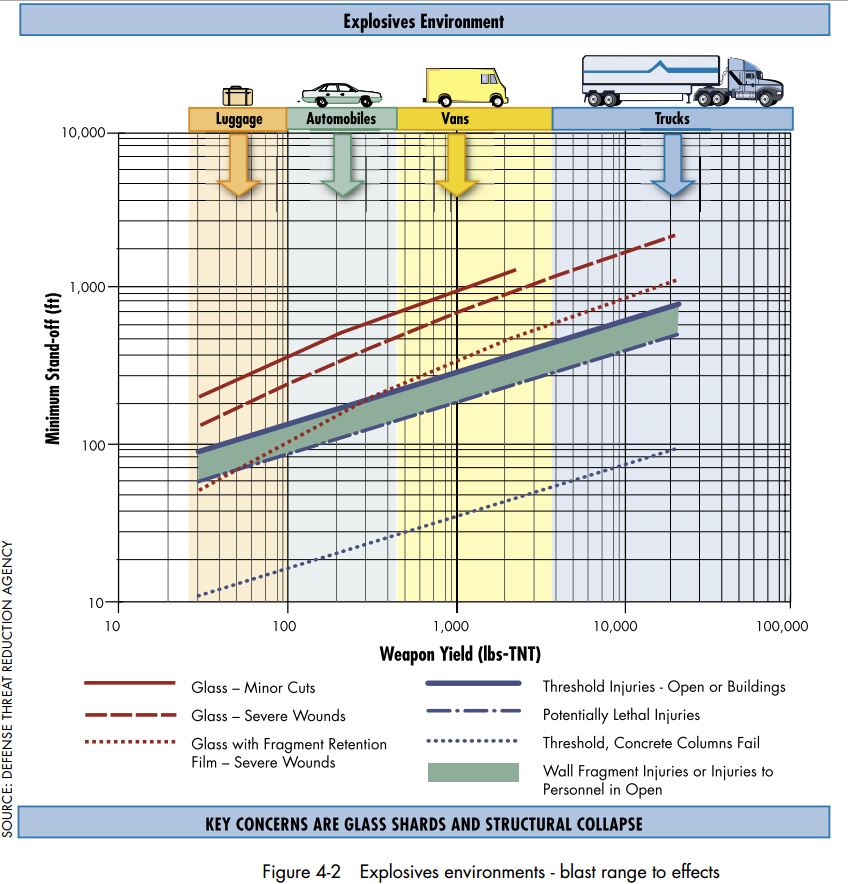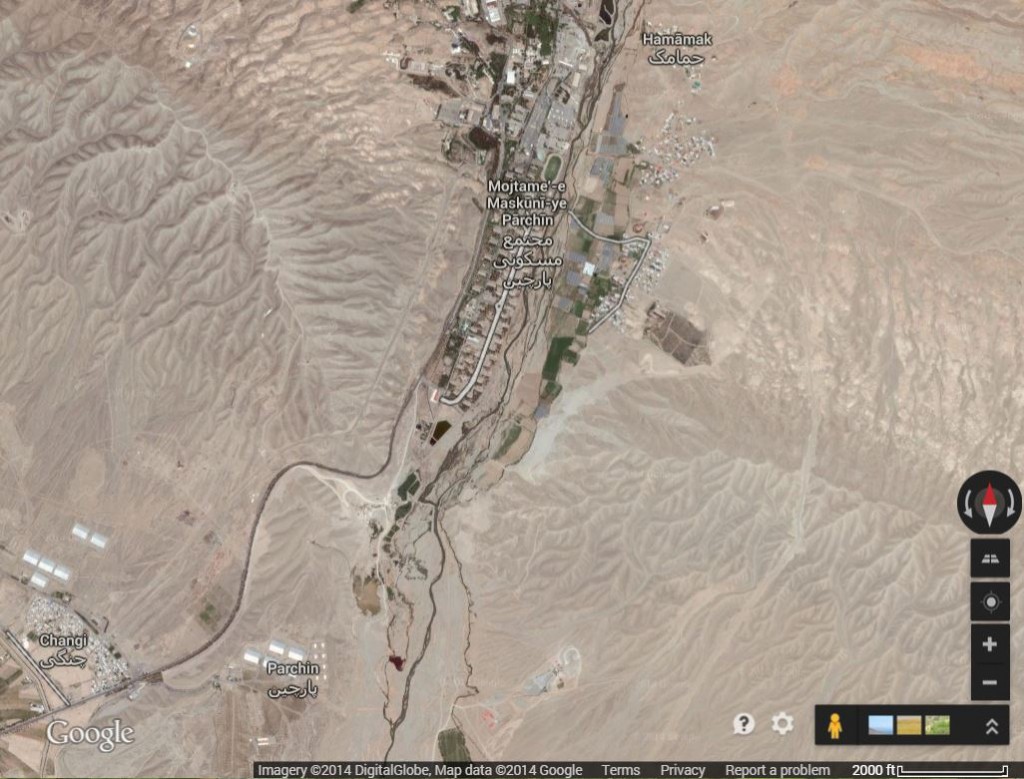Blast at Parchin Kills at Least Two; Timing Stinks
Detailed information is not yet available, but by all accounts there was a very large explosion east of Tehran Sunday night, around 11:15 local time. Many believe that the explosion took place at Parchin, the military site that has been at the center of controversy raised by those who accuse Iran of carrying out work there to develop an explosive trigger for a nuclear bomb. Some of the most detailed information comes from Thomas Erdbrink of the New York Times:
A mysterious explosion at or near an important military complex rocked the Iranian capital on Sunday, lighting up the skies over the city.
Iranian official sources denied the explosion had taken place at the complex, the expansive Parchin military site east of the city, where international monitors suspect Iran once tested triggers for potential nuclear weapons. But the enormous orange flash that illuminated Tehran around 11:15 p.m. local time clearly came from that direction, several witnesses said.
Officials at Iran’s Defense Industries Organization, though also denying that the explosion took place at Parchin, confirmed that two people were missing after “an ordinary fire” caused by “chemical reactions of flammable material” at an unspecified production unit, according to the semiofficial Iranian Students’ News Agency. There was no word on the location of the fire.
Witnesses in the east of Tehran said that windows had been shattered in the vicinity of the military complex and that all trees in a hundred-yard radius of two villages, Changi and Hammamak, had been burned. The villages are on the outskirts of the military site.
The map below shows the area in question:
As seen on the map, Changi is very close to Parchin, but Hammamak is on the other side of Parchin and the two villages are over three miles from one another. A blast fireball that scorched trees over three miles apart must have been quite spectacular.
Many factors go into calculating the strength of blasts, including the type of explosive and what type of containment might have been present. However, FEMA provides (pdf) this rough guideline (via DTRA) of the radius over which various types of damage might be expected to occur as a function of the amount of explosive material used:

Because it relates to assessing damage from terrorist bombs, the FEMA figure breaks the amounts of explosives down into the amounts that can be carried by cars, vans and large trucks. The Times story doesn’t report on how far away from the complex windows were shattered, but the effect of burned trees in villages over three miles from one another suggests that such damage would reach quite a ways. At the very least, it would appear that the blast had the equivalent of more than 10,000 pounds of TNT, and perhaps significantly more than that.
A report from BBC does give a blast radius for window breakage:
The pro-reform website Sahamnews said the explosion on Sunday evening was so intense that windows of buildings 15km (nine miles) away were shattered.
More caution is needed with this report than Erdbrink’s, but if true, windows breaking over nine miles away from the blast site takes it entirely off the FEMA chart into the equivalent of over 100,000 pounds of TNT or perhaps even a million.
By comparison, the fertilizer explosion at West, Texas involved 240 tons (= 480,000 pounds) of ammonium nitrate and broke windows seven miles away.
While it is widely known that Parchin is used for military purposes including munitions storage and explosives research, this Fars News Report on the blast, only available in Farsi at the time of this writing, translates to say the blast was at a waste tire warehouse. It is very hard to see how burning tires could produce such a large explosion, while a munitions cache could easily account for it.
Erdbrink concludes with acknowledgement that Israel and the West have been accused of attacks on Iranian facilities with links to the nuclear program:
From roughly 2010 until 2012, Iran was plagued by a series of mysterious explosions and occurrences involving critical gas pipeline infrastructure and military sites. In 2011 a huge explosion west of Tehran killed 17 people, including the head of the Revolutionary Guards’ missile program.
While officials say most of the disasters have been accidents, representatives of President Hassan Rouhani’s government have in the past accused Western powers and Israel of a campaign to sabotage Iran’s nuclear and missile programs.
Recall also that Iranian personnel associated with the nuclear program also have been subject to attack. Just last Friday, Iran complained again about IAEA leaks. Although the leak this time pertained to the timing of the next visit by IAEA officials for negotiations, in the past Iran has accused IAEA of leaking the identities of personnel in the nuclear program, enabling attacks on them.
And it is regard to this latest visit by IAEA officials that the timing of this blast becomes suspect. The new round of negotiations is beginning today and the IAEA personnel arrived early today Tehran time. It was already known that access to Parchin and obtaining more information from Iran concerning past activities at Parchin were on the agenda for the negotiations. That means that the blast took place in the very short window between confirmation that the negotiations were to begin and the arrival of IAEA officials.
Many immediately suspected Israel in the blast. See, for example, Tyler Durden’s piece here that summarizes these speculations.
Another possibility that I haven’t seen mentioned is the potential of a semi-intentional accident that would destroy the building that is at the heart of the negotiations. It is only a matter of days before satellite imagery of the blast site become public, so we will know fairly soon whether the particular building with the blast chamber in question was destroyed. If the site is completely destroyed, that would be a convenient way for Iran to prove, without saying it, that no further work of this type will take place.
Finally, there is one more curious incident that needs to be noted in the context of these other developments. I routinely monitor the recurring incidents along the border between Iran and Pakistan. Iran released additional information today on an incident they say took place in early September:
The IRGC Ground Force’s Quds Base announced in a statement in September that “a team of terrorists and outlaws attacked a checkpoint station in Saravan border region and intended to capture it, but the IRGC Quds Base forces accompanied by the local people and Basiji troops of the Sistan and Balouchestan province repelled the attack”.
In remarks to FNA on Tuesday, the IRGC Ground Force commander disclosed that during the failed attack 70 terrorists armed with 600kg of explosive materials and devices sought to blast the border checkpoint.
“The terrorists attacked checkpoint 171 with a large cache of munitions and a large number of forces,” Commander of the Islamic Revolution Guards Corps Ground Force Brigadier General Mohammad Pakpour told FNA on Tuesday.
“They rammed a vehicle laden with 600kg of explosives into the wall of the checkpoint building and a huge blast occurred and the checkpoint’s walls collapsed but after about three and a half hours of clashes, they couldn’t attain their goal,” he added.
So a force of 70 militants attacked a border checkpoint and used a truck filled with 1300 pounds of explosives to destroy the building at the checkpoint. With the ensuing battle lasting over three hours, we are left to wonder if additional forces and explosives were able to cross the border under cover of the battle, allowing them a month or so to covertly cross Iran to the area around Parchin. We are left to wonder if a truck filled with explosives could have found a weak point in a bunker for a munitions cache, triggering the massive blast.
I will keep an eye out for the emergence of imagery from the blast site and any analysis of where the blast was in relation to the disputed building.



“By comparison, the fertilizer explosion at West, Texas involved 240 tons (= 480,000 pounds) of ammonium nitrate and broke windows seven miles away.” — That’s a great comparison.
-I wonder if some Stuxnet-type program set off an industrial breakdown. Much like the centrifuge calamity we were trying to cause, but with more boom.
-But, they are working with high explosives and “accidents” do happen.
My initial reaction when I heard of this incident was to blame Mossad. After all, the Israelis seem determined to do anything to sabotage a nuclear deal between Iran and the P+1 group, and the timing of the incident fits perfectly with that explanation. However, after reflection, I think there are three other possibilities to consider. First, as has been suggested, this could simply be an accident. Handling explosives and nuclear material is a dangerous business and serious accidents can occur. A second possibility is that the Iranians did it themselves to remove this potential stumbling block to the negotiations without having to concede anything in the final agreement. And, finally, there is the possibility that hardliners in Iran did it to sabotage the negotiations. Americans tend to forget that there is opposition to a nuclear deal in Iran as well as in the United States and Israel. Reportedly the Supreme Leader is seriously ill, and hardliners in Tehran may think time is on their side.